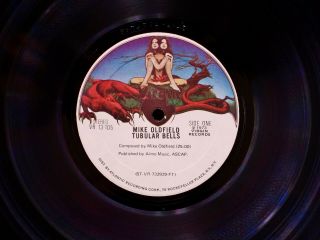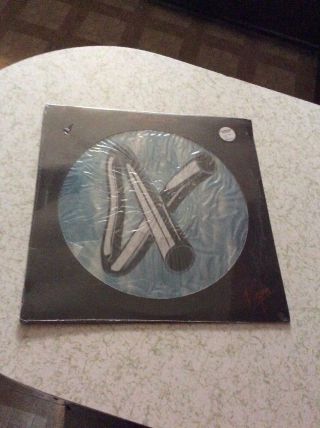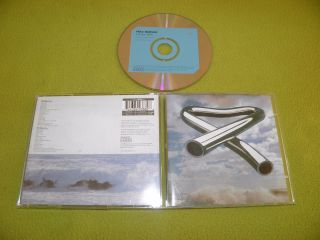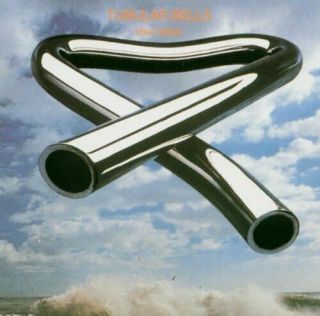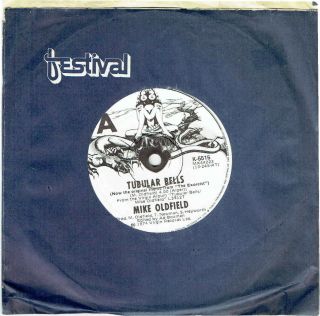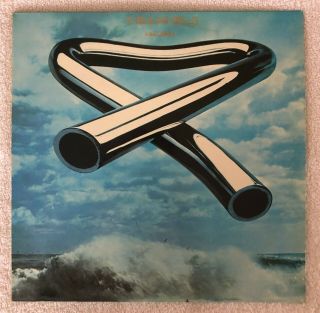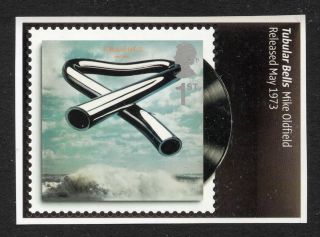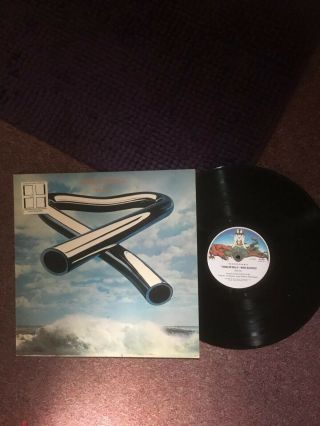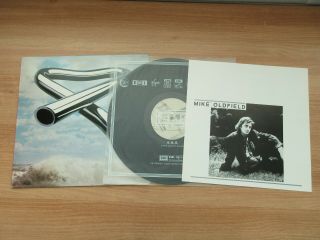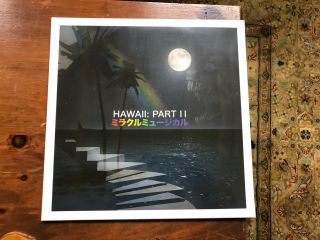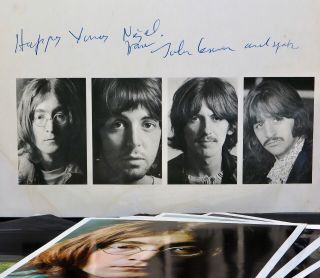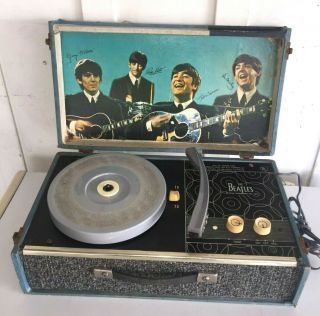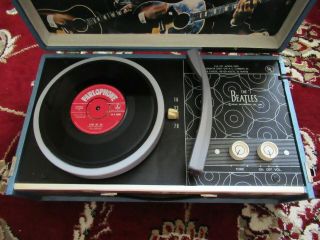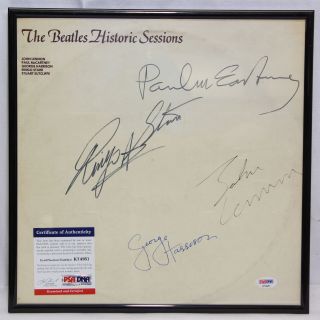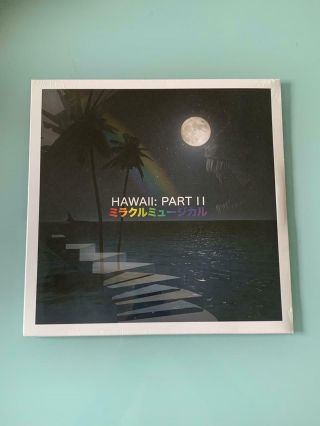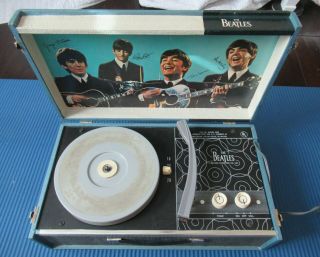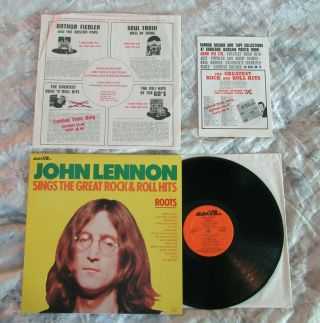Mike Oldfield ♫ Tubular Bells ♫ Rare EX 1973 Virgin Records Vinyl LP
Item History & Price
Tubular BellsStudio album by Mike OldfieldReleased25 May 1973RecordedNovember 1972 – April 1973StudioThe Manor, Oxfordshire, EnglandGenreProgressive rockLength49:16LabelVirgin
Mercury (2009 re-issue)ProducerTom Newman
Simon Heyworth
Mike OldfieldMike Oldfield chronologyTubular Bells
(1973)Hergest Ridge
(1974)Tubular Bells series chronologyTubular Bells
(1973)The Orchestral Tubular Bells
(1975)Singles from Tubular Bells"Mike Oldfield's Single"
Released: 28 June 1974Tubular Bells is the debut album by English musician and composer Mike Oldfield, released on Virgin Records on 25 May 1973. It comprises two mostly instrumental compositions of over twenty minutes each. Oldfield recorded it when he was 19 and played most of the instruments.Although sales were initially slow, Tubular Bells gained global attention when it was used on the soundtrack to the horror film The Exorcist (1973). In 1974, it reached number one in the UK, Australia and Canada, and number three on the US Billboard 200. It was the third-bestselling album of the 1970s in the UK. It is estimated to have sold more than 15 million copies worldwide, including more than 2.6 million in the UK. Tubular Bells was the first release on the Virgin Records label, and its success played an important part in the growth of the Virgin Group.Tubular Bells was orchestrated in 1973 by David Bedford for The Orchestral Tubular Bells, rerecorded as Tubular Bells 2003 for its 30th anniversary, and remastered and reissued in 2009 on Mercury Records. Oldfield recorded three sequels: Tubular Bells II (1992), Tubular Bells III (1998) and The Millennium Bell (1999). Its contribution to British music was recognised when Oldfield played extracts during the 2012 Summer Olympics opening ceremony in London.BackgroundOldfield learned to play the guitar at an early age, and was playing in folk clubs with schoolfriends by the age of 12 or 13. His teenage years were marred by trouble in the family home, and to escape from his problems Oldfield would spend many hours in his room practising the guitar and composing instrumental pieces, becoming an accomplished player. He formed a short-lived folk duo called the Sallyangie with his sister Sally, and after they broke up he became the bass player for the Whole World, a band put together by former Soft Machine member Kevin Ayers. The Whole World recorded their album Shooting at the Moon at Abbey Road Studios over a period of several months in 1970, and the 17-year-old Oldfield was fascinated by the variety of instruments available in the studios, which included pianos, harpischords, a Mellotron and various orchestral percussion instruments. When the group did not have a recording session booked until midday, he would arrive at the studios early and spend hours during the morning experimenting with the different instruments and learning how to play each of them.The Whole World broke up in mid-1971 and Ayers joined Gong for three months as a touring member of the band. While he was away he lent Oldfield a two-track Bang & Olufsen Beocord ¼" tape recorder. Oldfield modified the recorder by blocking off the erase head of the tape machine – this allowed him to record onto one track, bounce the recording onto the second track, and record a new instrument onto the first track, thus overdubbing his playing one instrument at a time and effectively making multi-track recordings. In his flat in Tottenham in north London, Oldfield recorded demos of four tracks he had been composing in his head for some years, using the tape recorder, his guitar and bass, some toy percussion instruments, and a Farfisa organ borrowed from the Whole World's keyboard player David Bedford. The demos comprised three shorter melodies (early versions of what would become the sections titled "Peace", "Bagpipe Guitars" and "Caveman" on the Tubular Bells 2003 version of the album), and a longer piece he had provisionally titled "Opus One". Oldfield stated that he had been inspired to write a long instrumental piece after hearing the track Septober Energy by Centipede. He was also influenced by classical music, and by experimental composer Terry Riley's 1969 work A Rainbow in Curved Air, on which Riley played all the instruments himself and used tape loops and overdubs to build up a long, repetitive piece of music.Late in 1971 Oldfield joined the band of Arthur Louis who were recording demos in the Manor Studio. The studio was being constructed in the former squash court of an old manor house in Shipton-on-Cherwell, Oxfordshire, which had recently been bought by the young entrepreneur Richard Branson and which was being turned into a residential recording facility run by his music production team of Tom Newman and Simon Heyworth. Oldfield was shy and socially awkward, but struck up a friendship with the two producers after they heard his guitar playing. Oldfield asked Newman to listen to his demos: however, these were still back in the flat in north London, so one of Louis' roadies offered to drive Oldfield to London and back to retrieve them. Newman and Heyworth made a copy of the demos, and promised Oldfield that they would speak to Branson and his business partner Simon Draper about them.Oldfield spent much of 1972 working with his old bandmates from the Whole World on their solo projects, while simultaneously trying to find a record label interested in his demos. Oldfield approached EMI, CBS and various other labels, but all the companies rejected him, believing the piece to be unmarketable without vocals. Increasingly frustrated with the record company rejections and short of money, Oldfield heard that the Soviet Union paid musicians to give public performances – according to him, he was at the point of looking through the telephone directory for the phone number of the Soviet embassy when he was called by Simon Draper, who invited Oldfield to have dinner with him and Branson on Branson's houseboat moored in London. Over dinner Branson told Oldfield that he liked the demos and invited Oldfield to come back to the Manor and spend a week there recording "Opus One".RecordingSide oneOldfield recorded "Opus One" during his one allotted week at the Manor in November 1972. The album was recorded on an Ampex 2-inch 16-track tape recorder with the Dolby noise-reduction system, which was the Manor's main recording equipment at the time. To create his work Oldfield asked Virgin for various instruments to be hired, which included guitars, various keyboards and percussion instruments. Oldfield has recounted differing stories over the years regarding the inclusion of the tubular bells: in an article about the album's making in Q in 2001 he suggested that they were among the instruments he asked Branson to hire, but in interviews in 2013 for Sound on Sound magazine and for a television documentary he stated that he saw them among the instruments being removed from the studios after John Cale had finished recording there, and asked for them to be left behind for his own recording sessions.Oldfield played the majority of the instruments on the album as a series of overdubs, which was an uncommon recording technique at the time. Despite various guitars being listed on the album sleeve, such as "speed guitars", "fuzz guitars" and "guitars sounding like bagpipes", the only electric guitar to be used on the album was a 1966 blonde Fender Telecaster which used to belong to Marc Bolan and to which Oldfield had added an extra Bill Lawrence pick-up. All the guitars were recorded via direct injection into the mixing desk. To create the "speed guitar" and "mandolin-like guitar" named in the sleeve notes, the tape was simply run at half speed during recording. An actual mandolin was only used on the final track, the "Sailor's Hornpipe". Oldfield also used a custom effects unit, named the Glorfindel box, to create the "fuzz guitars" and "bagpipe guitars" distortion on some pieces on the album. The Glorfindel box was given to David Bedford at a party, who then subsequently gave it to Oldfield. Tom Newman criticised the wooden cased unit in a 2001 interview with Q magazine, noting that it rarely gave the same result twice. The guitar was put up for auction a number of times by Bonhams in 2007, 2008 and 2009 with estimates of £25, 000–35, 000, £10, 000–15, 000 and £8, 000–12, 000 respectively before finally being sold for £6500 – the money was donated to the SANE charity. According to Phil Newell the bass guitar used on the album was one of his Fender Telecaster Basses.The short "honky tonk piano" section at 13:48 on side one was included as a tribute to Oldfield's grandmother, who had played the instrument in pubs before World War II. The staff and workers at the Manor made up the "nasal choir" that accompanies it.Vivian Stanshall, a former member of the comedic rock group Bonzo Dog Doo-Dah Band, was due to use the Manor after Oldfield, and had arrived while he was in the process of recording "Opus One" (he began to record his first solo album Men Opening Umbrellas Ahead). Oldfield was a fan of the way in which Stanshall had introduced the instruments one at a time on the Bonzos' song "The Intro and the Outro". He suggested to Newman that he would like Stanshall to introduce the instruments in the same manner for "Opus One"'s "finale" section, and Newman agreed to the idea. However, the shy Oldfield then needed some persuading by Newman to go and ask Stanshall if he would carry out the request. Stanshall readily agreed to be the "master of ceremonies" on the record, but Newman recalled that the job proved to be more difficult than anticipated, with Stanshall forgetting the names of the instruments and introducing them at the wrong points in the recording. Eventually Oldfield wrote out the list of instruments in order, indicating where Stanshall should introduce them. It was the way in which Stanshall said "plus... tubular bells" to introduce the last instrument in the finale that gave Oldfield the idea to call the album Tubular Bells.Producing the sound that Oldfield wanted from the tubular bells proved problematic: he wanted a loud note from them but both the standard leather-covered and bare metal hammers did not produce the volume that he wanted. In the end Newman obtained a heavier claw hammer and Oldfield used it to produce the desired sound intensity, cracking the bells in the process.Side twoOnce Part One of Tubular Bells had been recorded, Oldfield was allowed to stay on at the Manor to record additional overdubs during studio downtime. He spent Christmas and New Year at his family's home, but returned to the Manor from February to April 1973 to record the second part of his planned album. Branson had visited the Midem music conference in Cannes in January 1973 and pitched Part One to various music companies with the same lack of success that Oldfield had had, so by this time Branson and Draper had plans to set up their own record label, and make Tubular Bells its first release. Oldfield was not given the studio time as he had been for Part One, so Part Two was recorded over a period of three months whenever the studio was free. Oldfield has stated that he already had Part Two mapped out and sequenced by the time he came to record it.The "caveman" section in Part Two was the only part of the album to feature a drumkit (played by the Edgar Broughton Band's drummer Steve Broughton), which Oldfield later said made the section "fairly normal". The section began with a backing track of bass and drums, with Oldfield overdubbing all other instruments. The shouting sequence was developed near the end of the recording when he had practically finished recording the instruments for the section, but felt that it needed something else. Engineer Simon Heyworth recalled that Branson was getting impatient and pressuring Oldfield to deliver the album, and to include vocals on one of the tracks so that he could release it as a single. Angered by Branson's suggestion, Oldfield replied, "You want lyrics!? I'll give you lyrics!". Back at the Manor he drank half a bottle of Jameson's whiskey from the studio's cellar and demanded that the engineer take him to the studio where, intoxicated, he "screamed his brains out for 10 minutes" into a microphone, leaving him so hoarse that he couldn't speak for two weeks afterwards. The engineer ran the tape at a higher speed during the recording, so that upon playback the tape ran at normal speed, thus dropping the pitch of the voice track and producing the "Piltdown Man" vocals listed on the credits.The coda at the end of Part Two, "The Sailor's Hornpipe", was a track Oldfield had been performing since he was the bass player with the Whole World. It was originally preceded by a longer rendition of the piece, featuring a vocal contribution from Vivian Stanshall over musical backing and marching footsteps. According to the liner notes for the Boxed vinyl compilation, this session occurred at four in the morning after Oldfield, Stanshall and producer Newman had been drinking heavily. Newman placed microphones in various rooms of the Manor and began recording, and the trio set off on an unplanned tour of the house, with Oldfield on mandolin and Newman on acoustic guitar playing the "Sailor's Hornpipe" while Stanshall gave an inebriated, improvised tour of the Manor. In the end a more traditional instrumental version of the "Sailor's Hornpipe" was recorded for Tubular Bells, although Stanshall's version was later included in what the liner notes describe as "all its magnificent foolishness" on the Boxed compilation. It can also be found on the SACDrelease (multi-channel track only) and on the 2009 Mercury reissue of Tubular Bells. A Spanish release of the box set missed out the "Sailor's Hornpipe" altogether and ended with the ambient section preceding it.In the liner notes to the 2009 reissue of Magma's Mëkanïk Dëstruktïẁ Kömmandöh, an album recorded at the Manor at around the same time as Tubular Bells, Magma's leader Christian Vander claimed that "Mike Oldfield stole my music, more precisely, he stole some extracts from Mekanïk and The Dawotsin."ArtworkTubular Bells picture discThe cover of Tubular Bells was created by designer and photographer Trevor Key. In her obituary of Key for The Guardian in 1995, Sue Steward, who was Virgin Records' press officer in 1973, recalled suggesting Key as a possible candidate to create the album cover. Key was invited to Virgin to present his portfolio – among his images was one of a boiled egg dripping blood which Branson liked and wanted to use for the cover art because he wanted to call the album Breakfast in Bed, but Oldfield hated both the image and the title and rejected them. A modified version of the image with the blood replaced by yolk would later be used as the artwork for Oldfield's 1991 album Heaven's Open, his final album for Virgin Records.Steward accompanied Key to a beach on the Sussex coast to shoot the backdrop to the album cover. Key had brought with him the bones shown burning on the beach on the album's back cover, but the day was bitterly cold and it took some time to set light to them. The perfectionist Key also spent several hours photographing the seascape until had a shot of the waves that he was happy with. The triangular "bent bell" on the album cover was inspired by the damage Oldfield had caused to the tubular bells while playing them on the record. Key designed the bell and had the model constructed, which he then photographed in his studio and superimposed on the beach backdrop. Oldfield was captivated by the finished artwork, and insisted that on the cover his name and the album title should be in small letters and in a pale orange colour (chosen by Oldfield himself) so as not to distract from the overall image.According to Steward, Key was paid just £100 for his work on Tubular Bells. However, in partnership with fellow designer/photographer Brian Cooke, the Cooke-Key Associates agency enjoyed a close relationship with Virgin Records during the latter half of the 1970s, designing the Virgin logo and creating album covers for many of the artists signed to the label, including the covers of many of Oldfield's subsequent albums.The "bent bell" on the cover has become the image most associated with Oldfield, appearing on the cover art of all the Tubular Bells sequel albums, and is also used as the logo of his personal music company, Oldfield Music Ltd. The cover of Tubular Bells was among ten images chosen by the UK's Royal Mail for a set of "Classic Album Cover" postage stamps issued on 7 January 2010.Use in The ExorcistThe most important promotion for the record came from an unexpected source, when the introduction to Part One was chosen to feature in the film The Exorcist, which was released in the United States in December 1973 and in European cinemas in March 1974. According to British film critic Mark Kermode, the decision to include the music was the result of pure chance – director William Friedkin had decided to scrap the original score by Lalo Schifrin and was looking for music to replace it. Friedkin was visiting the offices of Ahmet Ertegun, president of Atlantic Records (which distributed Tubular Bells in the US), and picking up a white label of the album from the selection of records in Ertegun's office, he put it on the record player and instantly decided that the music would be perfect for the movie. Although the introduction only features briefly in two scenes in the movie, it has become the track most commonly associated with it. Oldfield has stated that he did not want to see the film because he considered it too scary.Critical receptionProfessional ratingsReview scoresSourceRatingAllMusicChicago Sun-TimesChristgau's Record GuideC+CreemC+Encyclopedia of Popular MusicQInfluential British DJ John Peel was an early admirer of the record, and played it on his Top Gear radio show on BBC Radio 1 on 29 May 1973, four days after the album's release, calling it "one of the most impressive LPs I've ever had the chance to play on the radio, really a remarkable record". Branson and Oldfield were listening to the show on Branson's houseboat, and Oldfield stated in his autobiography that Peel played the album in its entirety, although the running order from the BBC archives and existing audio copies of the programme show that Peel played Part One only.Peel reviewed the album for The Listener magazine the following week, describing it as "a new recording of such strength and beauty that to me it represents the first break-through into history that any musician has made". The UK's major music magazines were also unanimous in their praise of the album. Al Clark of NME said that the "veritable orgy of over-dubbing results in a remarkable piece of sustained music, never content with the purely facile yet equally disinclined towards confusing the listener". He concluded that "Tubular Bells ... is a superlative record which owes nothing to contemporary whims. It is one of the most mature, vital, rich and humerous [sic] pieces of music to have emerged from the pop idiom."[72] Melody Maker's Geoff Brown observed that "Tubular Bells is a vast work, almost classical in its structure and in the way a theme is stated and deftly worked upon" and that it was "an enjoyable, evocative album which bodes well for the future of both the country's newest label and of Mike Oldfield". Reviewing the whole batch of Virgin's first album releases in Sounds, Steve Peacock singled out Tubular Bells as the best of the bunch, saying that after careful listening he "ended up convinced that it really is a remarkable album", noting the "complex, interlocking carefully woven music that works its way though an enormous dynamic and emotional range", and stating, "I can't think of another album that I'd as unhesitatingly recommend to everyone who's likely to read this".[74] A more reserved review came from Simon Frith in Let It Rockwho felt that Tubular Bells was "more than an attractive wall-paper, more than a nature-film score, because of Mike Oldfield's ability to make what happens to the music self-sufficient and satisfying", but questioned why Peel and other critics viewed the album as rock music, and concluded that "Oldfield's concern is the sound of rock, but Tubular Bells lacks rock's other essence — energy. This is no way body music — no sex, no violence, no ecstasy; nothing uncontrolled, nothing uncontrollable."Tubular Bells was released in the US in October 1973, and Paul Gambaccini wrote an enthusiastic review of the album for Rolling Stone, calling it "the most important one-shot project of 1973" and "a debut performance of a kind we have no right to expect from anyone. It took Mike Oldfield half a year to lay down the thousands of overdubs required for his 49 minutes of exhilarating music. I will be playing the result for many times that long." He concluded, "I can say that this is a major work".[77] On the other hand, in an article in the same magazine seven months later which discussed the current top twenty albums on the Billboard chart, Jon Landau dismissed the record as "a clever novelty" and said, "Light, rather showy and cute in places, it probably makes pleasant background music for a dinner or conversation". Village Voice critic Robert Christgau was also left unmoved, saying, "The best I can come up with here is 'pleasant' and 'catchy'. Oldfield isn't Richard Strauss or even Leonard Cohen — this is a soundtrack because that's the level at which he operates."In a retrospective review for AllMusic Mike DeGagne called the album "arguably the finest conglomeration of off-centered instruments concerted together to form a single, unique piece" and stated that "the most interesting and overwhelming aspect of this album is the fact that so many sounds are conjured up, yet none go unnoticed, allowing the listener a gradual submergence into each unique portion of the music. Tubular Bells is a divine excursion into the realm of new-age music."AccoladesOldfield won the 1974 Grammy Award for Best Instrumental Composition.In Q magazine's 1998 list of "The 50 Best Albums of the '70s", Tubular Bells was placed at number six. In the Q & Mojo Classic special issue Pink Floyd & The Story of Prog Rock in 2005, the album was listed at number nine in its list of "40 Cosmic Rock Albums".Virgin GroupI never thought that the word 'tubular bells' was going to play such an important part in our lives ... Virgin going into space most likely wouldn't have existed if we hadn't hired that particular instrument.— Richard Branson, 2013The significance of this album to the Virgin empire is not lost on Richard Branson, who named one of his first Virgin America aircraft, an Airbus A319-112, N527VA Tubular Belle. Prior to this Virgin Atlantic had named a Boeing 747-4Q8, G-VHOT Tubular Belle, in 1994.In the United Kingdom Virgin Money signalled its entry into the banking sector in January 2012 with a television advertisement titled '40 Years of Better'. The advertisement opened with an image of a record orbiting the earth accompanied by the music of the introduction to Tubular Bells, signifying the beginnings of Virgin, and ended with a shot of the same record framed and hanging on the wall of the new bank. Two months later a Virgin Media TV advertisement starring Branson and actor David Tennant also featured the record, where a younger version of Branson is seen holding a copy of Tubular Bells under his arm upon exiting a time machine. However, the advert was withdrawn shortly afterwards following objections from the BBC that it was being used to endorse a rival TV service (in the advert Tennant is shown searching on Virgin's TiVo on-demand service for episodes of Doctor Who, a BBC series in which he formerly played the titular character).Cultural referencesThe use of the opening theme in the 1973 film The Exorcist gained the record considerable publicity and introduced the work to a broader audience. Along with a number of other Oldfield pieces the theme was used in the 1979 NASA movie The Space Movie. It has gained cultural significance as a 'haunting theme', partly due to the association with The Exorcist, and has been sampled by many other artists, such as Janet Jackson on the title track of her album The Velvet Rope.In television it was used in several episodes of the Dutch children's series Bassie en Adriaan, an episode ("Ghosts") of the BBC series My Family and an episode ("Poltergeist III – Dipesto Nothing") of Moonlighting. It was used in a television advertisement for the Volkswagen Golf Diesel in 2002 and in films such as 1983's Star 80, 1985's Weird Science, 2001's Scary Movie 2 (in a scene directly parodying The Exorcist), 2002's The Master of Disguise, 2004's Saved! and 2017's Abracadabra. The album is mentioned in the Only Fools and Horses episode "Fatal Extraction", although the cover of Tubular Bells II is shown on screen.Track listingAll tracks composed by Mike Oldfield, except where noted.1973 original releaseSide one"Tubular Bells, Part One" – 25:30Side two"Tubular Bells, Part Two" – 23:20




